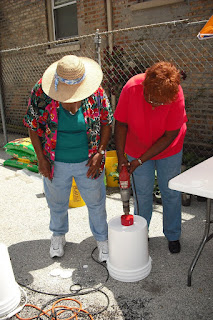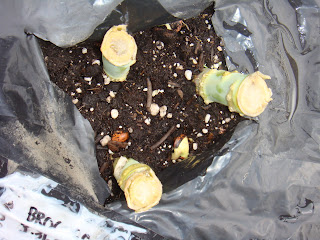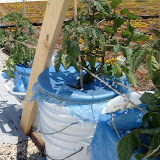The good: Seeds shared by our pal Erik Knutzen at Homegrown Evolution have emerged. I'm excited to see what they'll produce.
Labeled "mystery Greek squash,"I guess Erik himself isn't even certain


The bad: OK, maybe not bad, but frustrating. This is the Broccoli Romanesco, and wouldn't you be excited about growing it if it looked like this? But it doesn't. And we're about out of cool weather here in Chicago. I planted healthy starts on April 8 and this plant takes 75-100 days from transplant.
Your 75 days are about up, Mr Shrively

Walking through the garden, you can always find something to be thankful for, like Art with his drill securing another crossbar for the tomatoes. Plus, the prolific peapods in the background.
Art is a gardener's friend

Uh-oh. In my book, this falls into the category of really bad. These gorgeous little San Marzano tomato babies have blossom end rot. The starts were transplanted on April 29 in the greenhouse (even with low nighttime temps they got a lovely start) and set out a month later. Maybe they used up the cup of Espoma lime we mixed into the soil?
Today we gave them a quarter cup of hydrated lime
dissolved in a gallon of water
dissolved in a gallon of water

On the other hand, these early Stupice tomatoes are ripening nicely, with lots more to come.
I picked one today and ate half of it on the roof
before I remembered the gardener's friend downstairs
before I remembered the gardener's friend downstairs

The Kellogg's Breakfast tomatoes are coming right along too. With peak 80-90 days from transplant, we should be looking for ripe ones in a few weeks.

Saying goodbye: To the Indian Mustard (Wild Garden Pungent Mix), gone to bloom for the bees to explore. Despite the bounty to come, I'll miss our toss of heat-seeking greens.
I've already made a note to plant them again in 2010




































